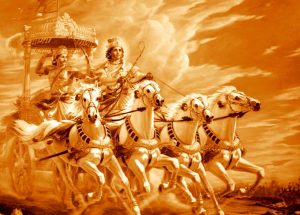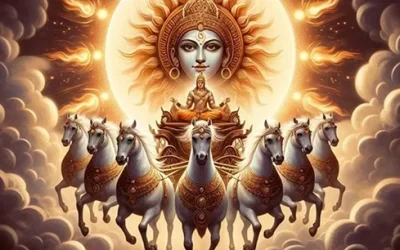The Bhagavad Gita: Exploring Its Teachings, Origins, and Timeless Wisdom
We all know about the Mahabharata, the famous ancient Indian epic. At the core, we have the war known as the Kurukshetra War. Prince Arjuna was torn and caught in a dilemma of having to fight against his kins, such as his granduncle Bhishma and his respected teacher, Drona. Heavied by doubt, he turns to his charioteer Krishna for counsel. This conversation between Arjuna and Krishna would eventually develop into one of the world’s most powerful spiritual texts- the Bhagavad Gita.
The Bhagavad Gita, or more simply known as the Gita, is an age-old lesson on life, duty, and spirituality. Let’s look at the history behind it, the lessons learned from it, and why it inspires people across cultures today.
History of the Bhagavad Gita: A Dialogue That Transcends Time
The Bhagavad Gita, or simply the Gita, is a scripture in the form of 700 verses written in the Mahabharata. On the eve of the climactic Kurukshetra War, Prince Arjuna, who was overcome with moral doubt, goes to Krishna for help. The conversation between them tackles deep philosophical questions beyond the immediate context of the battlefield.
The Bhagavad Gita is part of the Mahabharata, an ancient Indian epic composed by Sage Vyasa. It is believed that the Bhagavad Gita was written somewhere between the 5th century BCE and the 3rd century CE, a time when we see a shift in spiritual and philosophical thought in India. Such a universal concern with questions about duty and purpose and the nature of existence makes it relevant even today.
Understanding the origins of the Gita also provides an appreciation of how it emerged from a culture grappling with war, honour, and the quest for meaning in an ever-changing world.

The Main Themes and Teachings of the Bhagavad Gita
The Bhagavad Gita deals with fundamental questions about life, such as – How can someone live a spiritually meaningful life without withdrawing from society? What can a person do to live righteously while still maintaining family and social obligations?
Krishna provides Arjuna with several key teachings:
The Eternality of the Soul (Atman): Krishna teaches that the self is eternal and invincible; physical death will not impact the soul. He explains to Arjuna, “The soul is neither born, nor does it ever die; nor having once existed, does it ever cease to be. The soul is without birth, eternal, immortal, and ageless. It is not destroyed when the body is destroyed.” (Bhagavad Gita 2:20). This is a lesson that made Arjuna realize that he is not truly killing anyone, as the soul merely moves to another stage of reincarnation.
The Concept of Dharma (Duty): One of the Gita’s central themes is dharma, or duty. Krishna reminds Arjuna of his responsibility as a Kshatriya warrior to join the battle. Dharma means “duty,” and is derived from the Sanskrit root “dhr,” which means “what holds things up or sustains.” It is important to act with integrity and purpose, even in the face of personal hardship.
Inaction is Impossible: Krishna argues that choosing not to act is also a form of action. Hence, Arjuna cannot opt out of his duty by abstaining from fighting. This is a subtle criticism of ascetic philosophies that advocate complete withdrawal from life as a form of inaction. Instead, Krishna advises participation in life, but without attachment to the results—acting purely for the sake of duty.
The Source of Evil: Krishna teaches that the source of evil is not the actions themselves but the passions and desires that drive them. Thus, Arjuna action does not accrue bad karma since his intentions are pure.

The Paths to Liberation (Moksha): Krishna presents three ways through which one can act without accumulating bad karma:
Jnana Yoga (the Path of Knowledge): This path emphasizes understanding the ultimate reality that all life is interconnected. By recognizing the oneness of all beings, a person can rise above the illusion of self and act without attachment.
Bhakti Yoga (The Path of Devotion): This path teaches that all actions should be dedicated to Krishna with full devotion and surrender so that no bad karma is accrued. Devotion allows the individual to transfer the results of their activities to God.
Karma Yoga (The Path of Action): This path teaches people to perform their duties without attachment to the fruit. Thus, acting without desire for any fruit earns them freedom from the pitfalls of karma. According to Krishna, “He whose mind remains undisturbed amidst sorrow, who does not crave pleasure, who is free from attachment, fear, and anger, is called a sage of steady wisdom.” (Bhagavad Gita 2:56-57).
These three paths are presented to three different minds depending upon their own temperament and caste but together they form a whole guide to life to lived rightly and spiritually.
The Word of the Bhagavad Gita
Originally, it was a private dialogue between Arjuna and Krishna, but it has been written and made available for people by Sage Vyasa, who incorporated it into his great epic, Mahabharata. The Mahabharata and Bhagavad Gita was told by Vaisampayana, the disciple of Sage Vyasa, to King Janamejaya, and it has been passed on from generation to generation through oral tradition.
The text of the Bhagavad Gita has been preserved through manuscripts written on palm leaves over thousands of years, with multiple versions existing. The monumental task of compiling a critical edition of the Mahabharata was undertaken by the Bhandarkar Oriental Research Institute in Pune in the twentieth century, consulting more than 1,259 manuscripts. The Critical Edition of the Mahabharata was released on September 22, 1966, and has 19-volume, over 15,000 page edition is considered the most accurate version of the epic.
Significance of Bhagavad Gita
The Bhagavad Gita has an important part in Hindu philosophy, transcending its original context as a dialogue on a battlefield. Though it contains many of the actual teachings of the Vedic tradition, it makes them much more accessible and available to a greater audience across social and religious barriers. Unlike other Vedas that operated on the notion of limiting their use strictly to selected castes, the teachings of Gita are made free for all, and it offers guidance on how to live a life aligned with dharma.
It specifically emphasizes karma yoga, or selfless action, and brings together different philosophical traditions, such as the concepts of Advaita (non-duality) and Bhakti (devotion), making it a unifying text within Hinduism.
The Bhagavad Gita has long left its mark not only on Hindu philosophy but also as an influence on other dimensions of Indian culture, spirituality, and even global thought. Indeed, such great personalities as Mahatma Gandhi regard it as a spiritual guide, while many others around the world find inspiration in its teachings.

Conclusion
The Bhagavad Gita has profoundly affected Indian philosophical thought, particularly in developing the principles of Vedanta, Yoga and other Hindu philosophies. The Bhagavad Gita is one of the world’s most celebrated and respected texts. Its teachings on life, duty, and spirituality instil a timelessness in inspiring and guiding millions of people from diverse cultures and backgrounds. The message of the Gita is to bring hope and knowledge when tackling rising life challenges with strength and faith and to bring an understanding of self. It reminds us to know our purpose in life, carry out our duties and be at peace with ourselves.






